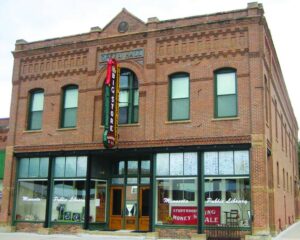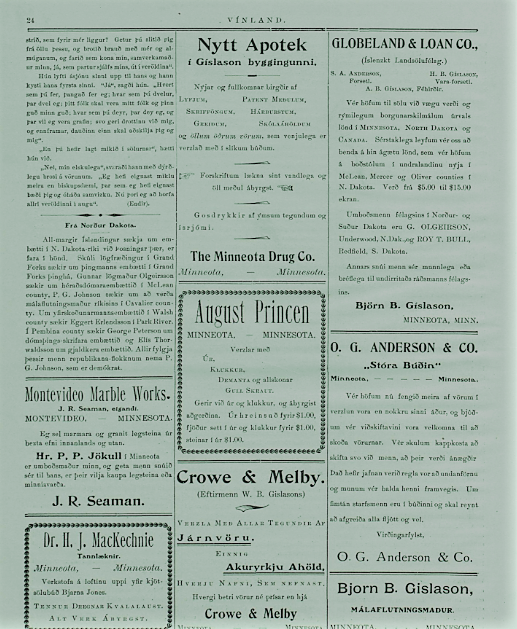Minneota is a town in Lyon County, Minnesota, roughly centrally located in the Icelandic community. The choice of location was related to the construction of a railroad across western Minnesota in 1876 and was first named Pumpa because it was the water association’s water pump. This pump was on private property so when it came to building a railway station, post office and other service companies, a site was chosen 2 km (0.8 miles) east. Norwegian immigrants are very important in the early years and a new name, Nordland, was chosen for the place and used until 1878. The people found this name awkwardly similar to the name of another village, Norseland, so it was decided to choose between two names, Horten or Jaegersville. After the election, the story goes that a man, dissatisfied with both names, stole the ballot box and destroyed all the votes. He may have been involved in sending the name Minneota to the Washington authorities, who approved it before the election. Now the new village was called Minneota, which is taken from the language of the Dakota Indians and means “a lot of water”. The choice is explained by the story of a Norwegian settler who, with the help of the indigenous people, searched for water with good results because water flowed out of the well. The natives then have shouted: “Minneota”. (MPN) Icelandic settlers moved west to new settlements in the years 1875-1880, some from Wisconsin and others directly from Iceland. It is clear that Gunnlaug Pétursson’s letters to relatives and friends in East Iceland had an effect, he encourages them to come to the settlements in Minnesota if they are considering emigrating to the west. Farming was not suitable for all western Icelanders, many chose day labor, either for farmers or in towns and villages. Soon people were looking for Minneota where some construction was taking place. There people worked as laborers, there were artisans, other merchants and finally some officials.

Ólafur Guðni Arngrímsson’s store, Big Store, was from the turn of the century one of the largest shopping malls in the county. Upstairs was a meeting room.
Trade and commerce: Jóhannes Halldórsson, who took the name Frost in the west, came west in 1873 and lived for five years in Milwaukee, Wisconsin. He moved to Minnesota in 1878 and was the first Icelander to settle in Minneota. He worked in a shop and in 1883 he opened his own shop in partnership with Jónatan Jónatansson. Their store was called Frost & Peterson. In 1886, the Icelanders founded a share-holder company called the Verslunarfélag Íslendinga (Icelandic Chamber of Commerce), which was founded to strengthen the members’ finances and improve their trade. The shares were $25. Among the founders of the company and its main administrators were Stefán Sigurðsson from Ljósavatn, Jósef Jósefsson and Björn Gíslason from Vopnafjörður, Einar Jónsson, Sigbjörn Hofteig, Guðmundur Grímsson and others. The organization flourished for ten years, then its assets were sold except for one property in Minneota. The aforementioned Guðmundur Grímsson (G. A. Dalmann in the west) settled in Minneota in 1879 and opened a grocery store there in 1888. Jón Stefánsson from Egilsstaðir in Vopnafjörður joined him in 1890 and they ran the store “Dalmann & Stephenson” together until the turn of the century. Bjarni Jónsson from Búastaðir in Vopnafjörður started a meat shop “B. Jones Meat Market” in 1889 which operated for many years. In 1898, the brothers Þorvaldur and Árni, Björn Gíslason’s sons, opened the store “Gislason Bros”. Stefán Sigurðsson from Ljósavatn opened a hardware store in partnership with an American in 1892, later bought his share and ran it alone for a few years. Snorri Högnason opened a dry goods store in 1892 and in the spring of 1893 Ólafur Guðni Ásgrímsson (O. G. Anderson) from Búastaðir in Vopnafjörður started a dry goods store. That same year, several of his countrymen teamed up with him to become one of the most powerful “Big Store” stores in southwest Minnesota.

Here is a page from Vínland that clearly shows the diverse activities of Icelanders in Minneota from 1900. The advertisements speak for themselves. At the top is Nytt Apotek which is located in the Gíslason building. It is clear that the “Gislason Bros” store was on its own premises. Next to it is an advertisement from Globe Land & Loan Co. directed by Björn B. Gíslason. At the top is S. A. Anderson who is Sigurður Vigfússon, son of Vigfús Andrésson. H. B. Gíslason and his brother A. B. Gíslason, both brothers of Björn. Below that advertisement is Ólafur Guðni Arngrímsson with his advertisement “Stóra Búðin” (Big Store) and below that Björn B. Gíslason lawyer. A dentist advertises his services on the floor above Bjarni Jónsson’s butcher shop (B. J. Meat Market) and above it is seen that Pétur Pétursson Jökull has a dealership for building materials.
Newspaper publishing and lawers: In the spring of 1895 Stefán Þorsteinn Jónsson (S. Th. Westdal) from Vopnafjörður and Gunnar Björnsson from Jökuldalur founded a printing company which they called “Westdal & Björnsson”. They bought the weekly paper Mascot, which was published in Minneota, and printed the paper and published it. Stefán bought Gunnar’s share two years later and continued printing and publishing. He also published “The Minnesota Good Templar” and was one of its editors. He also edited the Sunday school magazine of the Icelandic church association “Kennarinn”, edited by Reverend Björn B Jónsson. In March, 1902, the publication of “Vínland”, an Icelandic newspaper in Minneota, began and Gunnar Björnsson was the publisher. The editors were Reverend Björn B. Jónsson and Þórður Þórðarson, MD (Dr. Th. Thordarson) from Húnavatnssýsla. In 1904, Þórður became one of the editors, Rev. Björn the managing director, and the publication was handled by a new company, “Vínland Publishing Co”. The paper became popular and was considered well written, editor Þórður had the most content and many of his articles were considered extremely informative. Publication was stopped in February, 1907. Guðni Júlíus Oleson wrote about the paper in “Saga Íslendingar í Vesturheimi V” and briefly discussed its literary dispute with Lögberg in Winnipeg. He wrote: “Otherwise it can be said that the wording in both papers was well in line with what was customary in the literary controversies of Icelanders here in the west in previous years. In addition to what has now been mentioned, Vínland was free from all literary controversy, but placed great emphasis on presenting informative essays. Otherwise, Vínland was one of the best papers published here in Icelandic. It was probably impossible for the paper to sustain itself financially. Those closest to it had to work for it for little or no pay and even go into their own pockets to keep it alive. It was therefore not to be expected that it could stay afloat any longer. But it has its cultural place in the history of Western Icelanders and Minnesota Icelanders in particular.” Björn Björnsson from Hauksstaðir in Vopnafjörður was 5 years old when he came west with his father, Björn Gíslason, and siblings in 1879. He was well educated, studied law and became lawyer in Minneota. He was one of the main promoters of the “Globe Land & Loan Company”, which bought and sold land, and lent money. Kristján Magnússon (C.M. Gíslason), son of Magnús Gíslason from Bárðardalur, came west with his parents in 1873 and first lived in Wisconsin. He studied at the State University of Minneapolis and became a lawyer in 1894.
Physician and teachers: Þórður Þórðarson (Dr. Th. Thordarson) came west in 1887 and studied medicine at the “College of Physicians & Surgeons” in Chicago 1893-97. He started working in Minneota the same year and made a great impression on Icelandic society because he not only practiced medicine but also edited Vínland for its life. The minds of many young Icelanders in Minnesota tended to be educated early on, and many pursued an education. There were many opportunities, and it was one part of adapting to a young, American society to study in high schools. Teaching fascinated many e.g., Sigurður Sigvaldason from Búastaðir in Vopnafjörður graduated from the University of Minnesota in Minneapolis and became a teacher. In 1895, the twin sisters Jónína Rósa and Jóhanna Þórunn Jónatansdóttir, who both taught in Minnesota, graduated from the same school. They were the first Icelandic girls to complete university studies in North America.
Priests/Pastors: In the early Minnesota years, congregations were formed in the Icelandic settlements and villages, Minneota and Marshall. The priests Reverend Páll Þorláksson and Reverend Jón Bjarnason fulfilled their calling from New Iceland in Canada and became priests there. Reverend Páll actually founded the first Icelandic congregation in the Shawano area of Wisconsin in 1875 and served as a priest to Icelanders and Norwegians there. Although he went north to New Iceland, he was still considered the pastor of the congregation in Shawano. He closely followed his settlers in the United States and visited the young settlement in Minnesota in 1877. Reverend Jón Bjarnason visited the settlement a year later and stayed there for some time. He returned to the settlement in 1880 when he was on his way home to Iceland. The leaders of the congregations in Minnesota discussed the hiring of a priest with Rev. Jón and mentioned to him that there was interest in getting a priest from Iceland, and four were mentioned in the story: Rev. Jón Halldórsson, Rev. Þorvaldur Bjarnason, Rev. Valdimar Briem and Rev. Jens Pálsson. It is not clear whether Rev. Jón agreed to help with the call, but he recommended his countryman Rev. Halldór Briem in New Iceland. He accepted the call from Minnesota and came there in April 1881, and served the congregations for one year but then returned to Iceland. For several years the congregations were without priests, and it was in 1886 that Rev. Friðrik J. Bergmann visited the colony on his way to the congregations in N. Dakota. He had just graduated from a Lutheran seminary in Philadelphia. Reverend Friðrik stayed in Minnesota for a time and did many pastoral works but then continued his journey home to N. Dakota. Níels Steingrímur Þorláksson had been a contemporary of Reverend Friðrik at the seminary in Philadelphia, but had since gone to Norway for further studies. The Icelanders in Minnesota sent him a call there and he accepted it. Reverend Jón Bjarnason had then returned to the West and Níels accepted his ordination to the priesthood in Minnesota and then began working there. He worked in the settlement until 1894, then moved to the Park Settlement in N. Dakota, and his position in Minnesota was taken over by Rev. Björn B. Jónsson.
English version by Thor Group.
